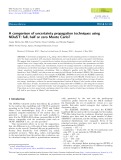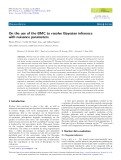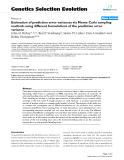
REGULAR ARTICLE
On the use of the BMC to resolve Bayesian inference
with nuisance parameters
Edwin Privas
*
, Cyrille De Saint Jean, and Gilles Noguere
CEA, DEN, Cadarache, 13108 Saint Paul les Durance, France
Received: 31 October 2017 / Received in final form: 23 January 2018 / Accepted: 7 June 2018
Abstract. Nuclear data are widely used in many research fields. In particular, neutron-induced reaction cross
sections play a major role in safety and criticality assessment of nuclear technology for existing power reactors
and future nuclear systems as in Generation IV. Because both stochastic and deterministic codes are becoming
very efficient and accurate with limited bias, nuclear data remain the main uncertainty sources. A worldwide
effort is done to make improvement on nuclear data knowledge thanks to new experiments and new adjustment
methods in the evaluation processes. This paper gives an overview of the evaluation processes used for nuclear
data at CEA. After giving Bayesian inference and associated methods used in the CONRAD code [P. Archier
et al., Nucl. Data Sheets 118, 488 (2014)], a focus on systematic uncertainties will be given. This last can be deal
by using marginalization methods during the analysis of differential measurements as well as integral
experiments. They have to be taken into account properly in order to give well-estimated uncertainties on
adjusted model parameters or multigroup cross sections. In order to give a reference method, a new stochastic
approach is presented, enabling marginalization of nuisance parameters (background, normalization...). It can
be seen as a validation tool, but also as a general framework that can be used with any given distribution. An
analytic example based on a fictitious experiment is presented to show the good ad-equations between the
stochastic and deterministic methods. Advantages of such stochastic method are meanwhile moderated by the
time required, limiting it’s application for large evaluation cases. Faster calculation can be foreseen with nuclear
model implemented in the CONRAD code or using bias technique. The paper ends with perspectives about new
problematic and time optimization.
1 Introduction
Nuclear data continue to play a key role, as well as
numerical methods and the associated calculation schemes,
in reactor design, fuel cycle management and safety
calculations. Due to the intensive use of Monte-Carlo
tools in order to reduce numerical biases, the final accuracy
of neutronic calculations depends increasingly on the
quality of nuclear data used. The knowledge of neutron
induced cross section in the 0 eV and 20 MeV energy range
is traduced by the uncertainty levels. This paper focuses
on the neutron induced cross sections uncertainties
evaluation. The latter is evaluated by using experimental
data either microscopic or integral, and associated
uncertainties. It is very common to take into account the
statistical part of the uncertainty using the Bayesian
inference. However, systematic uncertainties are not often
taken into account either because of the lack of information
from the experiment or the lack of description by the
evaluators.
Afirst part presents the ingredients needed in the
evaluation of nuclear data: theoretical models, microscopic
and integral measurements. A second part is devoted to the
presentation of a general mathematical framework related to
Bayesian parameters estimations. Two approaches are then
studied: a deterministic and analytic resolution of the
Bayesian inference and a method using Monte-Carlo
sampling. The next part deals with systematic uncertainties.
More precisely, a new method has been developed to solve the
Bayesian inference using only Monte-Carlo integration. A
final part gives a fictitious example on the
235
U total cross
section and comparison between the different methods.
2 Nuclear data evaluation
2.1 Bayesian inference
Let y¼~
yiði¼1...NyÞdenote some experimentally mea-
sured variables, and let xdenote the parameters defining the
model used to simulate theoretically these variables and tis
the associated calculated values to be compared with y.
Using Bayes’theorem [1] and especially its generalization to
*e-mail: edwin.privas@gmail.com
EPJ Nuclear Sci. Technol. 4, 36 (2018)
©E. Privas et al., published by EDP Sciences, 2018
https://doi.org/10.1051/epjn/2018042
Nuclear
Sciences
& Technologies
Available online at:
https://www.epj-n.org
This is an Open Access article distributed under the terms of the Creative Commons Attribution License (http://creativecommons.org/licenses/by/4.0),
which permits unrestricted use, distribution, and reproduction in any medium, provided the original work is properly cited.























